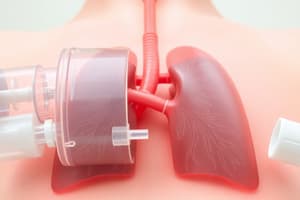Podcast
Questions and Answers
Which of the following is responsible for the movement of gas in the respiratory zone?
Which of the following is responsible for the movement of gas in the respiratory zone?
- Pressure changes
- Distances
- Diffusion (correct)
- Concentration gradients
Which structures occupy the majority of the lung volume?
Which structures occupy the majority of the lung volume?
- Respiratory bronchioles
- Lungs
- Pulmonary microvasculature
- Alveoli (correct)
Which muscles are involved in inspiration during the ventilatory process?
Which muscles are involved in inspiration during the ventilatory process?
- Scalenes and SCM
- Diaphragm and SCM
- Intercostals and scalenes
- Intercostals and diaphragm (correct)
What happens to the intrathoracic pressure during inspiration?
What happens to the intrathoracic pressure during inspiration?
What happens to the intrathoracic pressure during expiration?
What happens to the intrathoracic pressure during expiration?
What connects the chest wall and diaphragm to the lungs?
What connects the chest wall and diaphragm to the lungs?
What is the function of the pleural cavity?
What is the function of the pleural cavity?
Which lobe of the lung is located deep to the posterior thorax?
Which lobe of the lung is located deep to the posterior thorax?
What is the consequence of pleural effusion?
What is the consequence of pleural effusion?
What can cause pleural effusion?
What can cause pleural effusion?
Which structure contains the vocal folds?
Which structure contains the vocal folds?
What is the main site of gas exchange in the respiratory system?
What is the main site of gas exchange in the respiratory system?
Which region of the respiratory system is responsible for movement of gas driven by pressure gradients?
Which region of the respiratory system is responsible for movement of gas driven by pressure gradients?
Which structure lacks cartilage but is surrounded by smooth muscle?
Which structure lacks cartilage but is surrounded by smooth muscle?
What is the function of skeletal muscles in respiration?
What is the function of skeletal muscles in respiration?
Which structure leads to the larynx and is known as the 'back of the nose and throat'?
Which structure leads to the larynx and is known as the 'back of the nose and throat'?
Which region of the respiratory system is responsible for diffusion?
Which region of the respiratory system is responsible for diffusion?
Which structure is a midline, non-paired conducting airway?
Which structure is a midline, non-paired conducting airway?
What is the function of bronchi in the respiratory system?
What is the function of bronchi in the respiratory system?
Which structure is surrounded by smooth muscle and lacks cartilage?
Which structure is surrounded by smooth muscle and lacks cartilage?
Which condition is characterized by fluid in the pleural space, making it difficult to hear breath sounds and causing dullness to percussion?
Which condition is characterized by fluid in the pleural space, making it difficult to hear breath sounds and causing dullness to percussion?
What is the term for the presence of 'gunk' in the airways and alveoli, leading to decreased breath sounds and dullness to percussion?
What is the term for the presence of 'gunk' in the airways and alveoli, leading to decreased breath sounds and dullness to percussion?
Which condition is characterized by 'fine crackles' that sound like rubbing hairs together close to your ears and are commonly associated with pulmonary edema and congestive heart failure?
Which condition is characterized by 'fine crackles' that sound like rubbing hairs together close to your ears and are commonly associated with pulmonary edema and congestive heart failure?
What is the term for a high-pitched, musical sound on expiration that occurs when a small airway is narrowed or constricted?
What is the term for a high-pitched, musical sound on expiration that occurs when a small airway is narrowed or constricted?
Which condition is characterized by a louder, harsher sound on inspiration and sometimes on expiration, indicating a narrowing or constriction of the upper airways?
Which condition is characterized by a louder, harsher sound on inspiration and sometimes on expiration, indicating a narrowing or constriction of the upper airways?
What is the term for the consequence of pulmonary disease where the airspaces are filled with fluid, making it difficult to hear breath sounds and causing dullness to percussion?
What is the term for the consequence of pulmonary disease where the airspaces are filled with fluid, making it difficult to hear breath sounds and causing dullness to percussion?
Which condition is characterized by 'gunk' collecting in the airways and alveoli, leading to coarse crackles and decreased breath sounds?
Which condition is characterized by 'gunk' collecting in the airways and alveoli, leading to coarse crackles and decreased breath sounds?
What is the term for the consequence of pulmonary disease where the fluid is 'in the way' of auscultation and the echo from percussion, causing difficulty in hearing breath sounds and dullness to percussion?
What is the term for the consequence of pulmonary disease where the fluid is 'in the way' of auscultation and the echo from percussion, causing difficulty in hearing breath sounds and dullness to percussion?
Which condition is characterized by fluid or secretions in the small airways, resulting in 'fine crackles' that sound like rubbing hairs together close to your ears?
Which condition is characterized by fluid or secretions in the small airways, resulting in 'fine crackles' that sound like rubbing hairs together close to your ears?
What is the term for the consequence of pulmonary disease where a small airway 'snaps' open during some types of COPD, resulting in fine crackles?
What is the term for the consequence of pulmonary disease where a small airway 'snaps' open during some types of COPD, resulting in fine crackles?
Flashcards are hidden until you start studying




